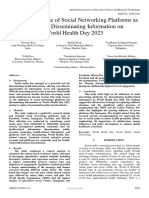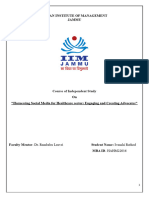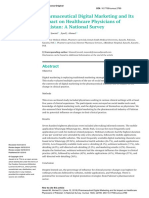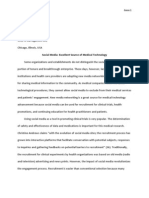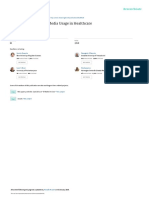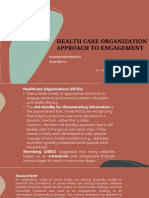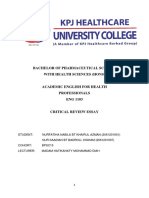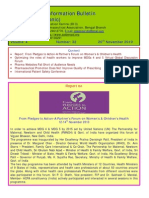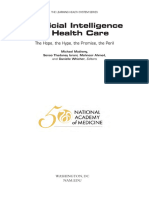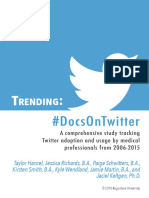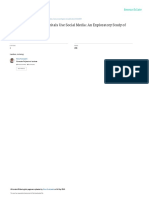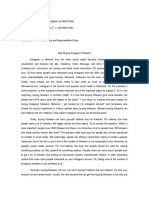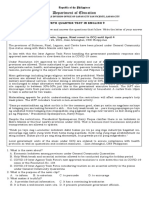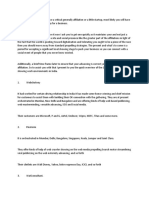Article - Wjpps - 1467357631 Social Media
Article - Wjpps - 1467357631 Social Media
Uploaded by
tonyannan5Copyright:
Available Formats
Article - Wjpps - 1467357631 Social Media
Article - Wjpps - 1467357631 Social Media
Uploaded by
tonyannan5Original Title
Copyright
Available Formats
Share this document
Did you find this document useful?
Is this content inappropriate?
Copyright:
Available Formats
Article - Wjpps - 1467357631 Social Media
Article - Wjpps - 1467357631 Social Media
Uploaded by
tonyannan5Copyright:
Available Formats
See discussions, stats, and author profiles for this publication at: https://www.researchgate.
net/publication/318461475
EFFECT OF SOCIAL MEDIA IN HEALTH CARE: USES, RISKS, AND BARRIERS
Article in WORLD JOURNAL OF PHARMACY AND PHARMACEUTICAL SCIENCES · June 2016
CITATIONS READS
8 15,992
7 authors, including:
Shashi Pratap Singh Rai Awani
Pranveer Singh Institute of Technology Pranveer Singh Institute of Technology
12 PUBLICATIONS 35 CITATIONS 42 PUBLICATIONS 553 CITATIONS
SEE PROFILE SEE PROFILE
Ankita Wal Dr. Gaurav Tiwari
Pranveer Singh Institute of Technology Pranveer Singh Institute of Technology
79 PUBLICATIONS 249 CITATIONS 91 PUBLICATIONS 1,539 CITATIONS
SEE PROFILE SEE PROFILE
Some of the authors of this publication are also working on these related projects:
"Development of Topical Polyherbal ethosomal gel for treatment of Diabetic Neuropathy", sanctioned by COUNCIL OF SCIENCE AND TECHNOLOGY, U.P. 2018. View
project
INTELLECTUAL PROPERTY RIGHTS AND DRUG REGULATORY AFFAIRS: A TEXT BOOK NIRALI PRAKASHAN View project
All content following this page was uploaded by Shashi Pratap Singh on 17 July 2017.
The user has requested enhancement of the downloaded file.
WORLD JOURNAL OF PHARMACY AND PHARMACEUTICAL SCIENCES
Singh. World Journal of Pharmacy and Pharmaceutical Sciences
SJIF Impact Factor 6.041
Volume 5, Issue 7, 282-303. Review Article ISSN 2278 – 4357
EFFECT OF SOCIAL MEDIA IN HEALTH CARE: USES, RISKS, AND
BARRIERS
Shashi Pratap Singh, Dr. A.k. Rai, Ankita Wal, Dr.Gaurav Tiwari, Ruchi Tiwari, Asfa
Parveen
Dean R&D Department of Pharmacy PSIT Kanpur, India.
M.Pharma Research Scholar PSIT Kanpur, India.
Article Received on ABSTRACT
05 May 2016,
Social media are now providing a space to discuss medical conditions
Revised on 26 May 2016,
Accepted on 15 June 2016, outside of the healthcare providers’ office. Patients and their families
DOI: 10.20959/wjpps20167-6783 use social media technologies to share their experiences and their
findings and educate others with similar conditions. Social media
*Corresponding Author provides a forum for reporting personal experiences, asking questions,
Dr.Pranay wal and receiving direct feedback for people living with a disease. The
Dean R&D Department of
many uses of social media applications in health include: Access to
pharmacy PSIT Kanpur,
India. educational resources by health providers and patients. Physicians
Shashi Pratap Singh
most often join online communities where they can read news articles,
M.Pharma Research listen to experts, research medical developments, consult colleagues
Scholar PSIT Kanpur,
regarding patient issues, and network A survey of more than 4,000
India.
physicians conducted by the social media site Quantia MD found that
more than 90% of physicians use some form of social media for personal activities,
whereas only 65% use these sites for professional reasons. There are many existing examples
of successful health organisation efforts in both the public and private sectors. Private health-
-‐care organisations, such as the Mayo Clinic, government public health agencies, such as the
United States Centers for Disease Control (CDC)and internationally, notably the World
Health Organisation (WHO) have all developed successful social media programs which
continue to grow. A major risk associated with the use of social media is the posting of
unprofessional content that can reflect unfavourably on HCPs, students, and affiliated
institutions. Physicians and other healthcare providers should not discuss patients’ illnesses,
medical conditions, or personal information online without the patients’ permission. Health
www.wjpps.com Vol 5, Issue 7, 2016. 282
Singh. World Journal of Pharmacy and Pharmaceutical Sciences
care providers also face limitations and barriers if they want to share patient health stories
using social media.
KEYWORDS: Social media, World Health Organisation, Centers for Disease Control,
Physicians, HCPs,
INTRODUCTION
Technological advances in health care have resulted in enthusiasm and apprehension. The
general public sees social media as efficient and accessible, but health care has been slow to
embrace this advance in communication.[1] The use of social media by health professionals to
deliver patient care has garnered much debate over the past few years since the creation and
viral expansion of multiple online social media sites. The term ―social media‖ was derived
from the evolution of Web 2.0 applications that are inherently open and social in nature and
integrate user-added value into traditional Web platforms.[2] Healthcare culture is rapidly
changing and patients are beginning to be part of the healthcare system rather than the object
of it. Patient-empowering technology, like social media, has started to change the way we
practice medicine and will continue to do so. Internet and mobile social media are the process
in which people use online applications and platforms to share content. links, and information
through dialogue. The rapid emergence of social media in the past 10 years has been
accompanied by a flood of individuals and businesses in every industry seeking to use new
tools to communicate with peers, family, friends, colleagues, and potential customers. To say
that social media is transforming the way people communicate hardly overstates the
situation.[3] Although health activity on social media lags behind non-health related activity, it
is expected to reach its full potential, and to catch up in the near future.[4]
Social media are now providing a space to discuss medical conditions outside of the
healthcare providers’ office.[5] Patients and their families use social media technologies to
share their experiences and their findings and educate others with similar conditions. They
repackage the information they find for others, creating forums for knowledge discovery and
Discussion.[6] For example, approximately two-thirds of posts in Facebook communities
dedicated to diabetes include unsolicited sharing of diabetes management strategies and over
13 % of posts provide feedback to information requested by other users.[7]
www.wjpps.com Vol 5, Issue 7, 2016. 283
Singh. World Journal of Pharmacy and Pharmaceutical Sciences
Social media provides a forum for reporting personal experiences, asking questions, and
receiving direct feedback for people living with a disease. Through social media, support
groups have found a new platform for organizing as patients and family caregivers share their
experiences, seek consolation online, and connect with other.[6,8] Indeed, 620 breast cancer
groups exist on Facebook, containing a total of 1,090,397 members. 46.7 % of these groups
were created for patient/caregiver support.[9] Healthcare professionals are also using social
media tools, with a growing number of physicians in this group. For example, individual
physicians can reach their patients through Twitter to update them with therapeutic
advancements, to answer disease-related questions, or simply to provide advice or
reminders.[8]
Social media has many unique features
• Allow a variety of content formats (text, photos, multimedia).
• Enable high-speed and large-scale reach for information sharing and distribution.
• Provide different levels of communications: One-toone, one-to-many, and many-to-many.
• Allow synchronous real-time and asynchronous communication.
• Easy to access with computers, tablets, and mobile devices, and does not require special IT
skills.
• Almost free of charges.
• Results can be tabulated and measured.[10]
These features provide social media with the ability to facilitate communication and
information sharing among healthcare providers themselves and their consumers. Social
media can, therefore, accelerate innovation via clinical trial recruitment and research
collaboration. It can also play a significant role in health outcome by monitoring both patients
and populations, in addition to managing care and wellness. Though they came into this arena
late, healthcare organizations, physicians, and other care providers are using this powerful set
of tools at different levels with varying perspectives. There is enough evidence to support the
view that the use of social media in health care is growing. For example, the number of
articles indexed on PubMed has nearly doubled every year for the last 4 years.[11]
Demographics of Social Media Use
Social media is now a regular part of daily life. In the US, it has grown from being used by
5% of all adults in 2005, to half of all adults (50%) in 2011.[12] A recent report showed that
between June 2009 and June 2010, the amount of time that people spent on social networking
www.wjpps.com Vol 5, Issue 7, 2016. 284
Singh. World Journal of Pharmacy and Pharmaceutical Sciences
sites increased by 43% and continued to become the single greatest time-consuming Internet
activity.[13]
Examples of social media sites
A social networking website that allows users to create a personal profile, connect with
others, exchange messages, and join common-interest user sites. It is one of the most popular
sites on the Internet, with more than 1 billion active users.[14]
YouTube
A media sharing platform that allows users to view and share videos with a global audience.
It can provide quick bursts of information or entertainment (or both). YouTube has more than
1 billion unique users who visit each month, and 100 h of videos are uploaded every
minute.[15]
Twitter
A micro-bloggingsite that allows users to communicate with each other and share information
through short 140-character messages or ―tweets.‖ It is one of the fastest growing sites, with
255 million monthly active users and 500 million tweets sent per day.[16]
LinkedIn
A dynamic business-oriented platform where people share credentials and professional
accomplishments and discover potential colleagues. It grows by more than two new accounts
every second.[17]
Wikipedia
A free online encyclopedia that anyone can edit. While it is one of the most comprehensive
sources of online knowledge, it can also be a frequent source of misinformation.
WhatsApp Messenger
A cross-platform mobile messaging application which allows users to exchange messages.
Because it uses the internet data plan used for E-mail and web browsing, it carries no cost.
Besides basic messaging, the users of this application can create groups, send each other
unlimited images, video, and audio media messages. WhatsApp users now send 1 billion
messages each day.[18]
www.wjpps.com Vol 5, Issue 7, 2016. 285
Singh. World Journal of Pharmacy and Pharmaceutical Sciences
Current Social Media Use in Health Care
Social media are becoming present in many areas of health care. PatientsLikeMe is a
platform that incorporates patient education with online peer-to-peer communication, using
information sharing about conditions, symptoms, and treatments to link patients
together.[19,20]
The many uses of social media applications in health include: Access to educational
resources by health providers and patients.[21-23]
PARTICIPATION IN SOCIAL MEDIA
By health care professionals (hcps)
Social media provide HCPs with tools to share information, to debate health care policy and
practice issues, to promote health behaviors, to engage with the public, and to educate and
interact with patients, caregivers, students, and colleagues.[24,25,26,27] HCPs can use social
media to potentially improve health outcomes, develop a professional network, increase
personal awareness of news and discoveries, motivate patients, and provide health
information to the community.[25,28]
Physicians most often join online communities where they can read news articles, listen to
experts, research medical developments, consult colleagues regarding patient issues, and
network.[29] There they can share cases and ideas, discuss practice management challenges,
make referrals, disseminate their research, market their practices, or engage in health
advocacy.[26,30] A growing minority of physicians also uses social media to communicate
directly with patients to augment clinical care.[29,30] A survey of more than 4,000 physicians
conducted by the social media site QuantiaMD found that more than 90% of physicians use
some form of social media for personal activities, whereas only 65% use these sites for
professional reasons.[26,29] Nearly a third of physicians have reported participating in social
networks.[28]
Unlike physicians, pharmacists have been relatively slow to adopt social media. Much of the
growth in the professional use of social media among this group appears to involve
pharmacist-specific social networks. Surveys have shown that many pharmacists use
Facebook. Although this use is most often for personal communications, more than 90 pages
on Facebook are related to the pharmacy profession, such as the Pharmacists Interest Page,
the American Pharmacists Association, and the Cynical Pharmacist. Only 10% of
www.wjpps.com Vol 5, Issue 7, 2016. 286
Singh. World Journal of Pharmacy and Pharmaceutical Sciences
pharmacists use Twitter, and a search for ―pharmacist‖ on LinkedIn identified 274,981
profiles.[31]
The use of social media by hospitals
People appreciate businesses that speak in a human voice. Nevertheless, many healthcare
organizations have been slow to adopt the social media, mainly because executives have not
yet realized the benefits of these platforms. Studies have shown that teaching hospitals and
those with high bed capacities adapt more rapidly to the social media.[32] Another interesting
observation regarding the adoption of social media by an organization is that it often begins
at the bottom when engagement needs to commence from the top. It is much easier to obtain
executive support if you can show that your efforts will be in line with your facility’s core
business objectives. Social media can help hospitals in different ways. It can increase patient
volume, reach a new audience, introduce new services, create awareness, improve outcomes,
provide excellent customer service and maintain the reputation of the organization. An
example of using social media platforms is Facebook, which is technically a free advertising
resource that may be utilized for local, national, and global exposure of practice/healthcare
organizations. It can offer paid advertisement placement, which is different from search
engine pay per click adverts since Facebook has the ability to better target advertisements in
its users news stream, based on having information about their users and users’ preference.[33]
Hospitals across the country are turning to social media as a means of distributing their
message, educating their patients, and marketing their services. Barry[34] identified the
primary social media uses for 1800 hospitals using social media: supplying information to a
general audience (97%), providing content about the entire organization (93%), announcing
news and events (91%), furthering public relations (89%), and promoting health (90%).
Hospital systems such as the Mayo Clinic, Henry Ford Health System, Innovis, and Scripps
Health use blogs—or interactive, informal communication Web-based pages, linked with
Facebook, Twitter, and YouTube—to expand their reach to patients.[35]
The importance of social media for health organisations relates to their need to manage their
online reputation while combating then spread of misinformation and opinions based on
fallacy. While a growing body of scholarly evidence links online heath information to
positive health- related behaviors, the growth and ease of social media platforms has also
resulted in concerns about the quality and reliability of information provided through this
medium.[36] For example, one study examining urinary incontinence resources on Facebook,
www.wjpps.com Vol 5, Issue 7, 2016. 287
Singh. World Journal of Pharmacy and Pharmaceutical Sciences
Twitter, and YouTube found that the majority of information provided was not useful,
consisting of advertisements for commercial products. These were in head to head
competition with the fewer evidence--‐based YouTube videos from reputed health--‐care
professionals and professional organisations.[37]
There are many existing examples of successful health organisation efforts in both the public
and private sectors. Private health--‐care organisations, such as the Mayo Clinic,[38]
government public health agencies, such as the United States Centers for Disease Control
(CDC)[39] and internationally, notably the World Health Organisation (WHO) have all
developed successful social media programs which continue to grow.[40].
Table: 1[41] Prominent Types of Social Media
Type of Social Media Description Examples
Online journals that are presented
in reverse chronological order with
most recent posts generally Blogger;
coming first. These can consist of http://www.blogger.com
accounts of bloggers’ personal LiveJournal;
Blogs
lives or can be themed. Entries http://www.livejournal.com
vary in length and frequency, WordPress;
which are at the discretion of the http://www.wordpress.org
author. Entries often contain
multimedia content.
Similar to blogs, but posts are
much shorter. Posts can link to
external content or contain Twitter;
messages about the author’s http://www.twitter.com
current ―status‖. Twitter prompts Tumblr;
Microblogging
bloggers by asking ―What’s http://www.tumblr.com
happening?‖, limits posts to 140 FourSquare;
characters and facilitates posting www.foursquare.com
and reading via text messaging and
mobile internet.
Allow users to build profiles and
extensive networks with other Facebook;
users. Often users share updates http://www.facebook.com/
about themselves, links to external MySpace;
Social Networking Sites
content, photos and videos. Users http://www.myspace.com/
are usually able to interact via LinkedIn;
public message postings and http://www.linkedin.com/
commenting on conten.
Websites that allow for posting, YouTube;
sharing, and commenting on http://www.youtube.com/
Multimedia Sharing Sites
photos and videos. Often these are Flickr;
linked to other forms of social http://www.flickr.com/
www.wjpps.com Vol 5, Issue 7, 2016. 288
Singh. World Journal of Pharmacy and Pharmaceutical Sciences
media. Videos that are spread in SlideShare;
this manner are often referred to as http://www.slideshare.net/
―viral‖.
USES FOR SOCIAL MEDIA IN HEALTH CARE
Professional Networking
The most popular social media sites for physicians are those where they can participate in
online communities, listen toclass, or creating a class hashtag so that resources such as
videos, websites, articles, and photographs could be shared. Media sharing sites such as
YouTube can also be used in the classroom to stimulate discussion, to illustrate a point, or to
reinforce a concept. Students can view a video and then respond to questions that promote
clinical reasoning.[42] The incorporation of social media into clinical education has met with
mixed reviews, however. Courses that incorporate such tools have generally been positively
received, but in some cases, students have reported feeling that the use of Facebook for
teaching purposes is an intrusion into their social lives.[43] Balancing the enhanced
communication opportunities provided by social media with the downside of increased
distraction in an educational environment is also a challenge.[43]
Social media use for health awareness
Studies demonstrate that a growing number of educational institutions are emphasizing and
training future medical and allied health practitioners on the importance of using social media
as an effective means to disseminate information amongst patients and clients.[44] For
example, nursing students have been encouraged to move beyond synthesizing pamphlets and
flyers as a means of disseminating information to patients, and have instead been equipped
with resources to create 3-to-5 min YouTube videos to distribute using various social media
platforms.[44] Moreover, a recent study demonstrated that utilizing Twitter and Facebook as
supplementary tools for delivering educational content can be an effective way to engage
medical trainees.[45] According to a recent study, 89 % of 291 polled continuing medical
education course participants reported using social media, with most common platforms
being YouTube and Facebook.[46]
Professional medical societies such as the American Society of Clinical Oncology (ASCO)
have been successfully using social media sites like Twitter to report clinical news from
scientific sessions, to discuss treatment issues, and to facilitate a broader dialogue amongst
physicians and healthcare professionals.[47] Additionally, studies have indicated that social
media can have tremendous value vis-a-vis epidemiological surveillance, allowing for
www.wjpps.com Vol 5, Issue 7, 2016. 289
Singh. World Journal of Pharmacy and Pharmaceutical Sciences
reporting cases in real time and permitting the monitoring of outbreaks around the world. [48]
Overall, there is a growing pull amongst physicians to utilize social media as a means of
ensuring the proper dissemination of information to their patients in order to counteract
scientifically questionable publications and educational videos.[49] Social media can facilitate,
enhance, and improve physician–patient communication by allowing physicians and
organizations to become more accessible and approachable.[50] Patients report that access to
online health information makes them feel empowered because they have the knowledge to
ask their physicians well-informed questions.[50]
Given time-restricted consultations, patients perceive the Internet to be particularly useful for
confirming and expanding on information. Patients see the Internet as an additional resource
to support existing and valued relationships with their physician.[51]
Professional Education
The communication capabilities provided by social media are also being used to improve
clinical education. The high usage rate of social media by 18- to 29-year-olds has motivated
the adaptation of clinical curricula to reflect the changing habits and culture of incoming
students.[52,53] Many studies have described the use of social media tools to enhance clinical
students’ understanding of communication, professionalism, and ethics. Universities are also
using social media to recruit students, to increase access to academic libraries, and to create
virtual classrooms and office hours, as well as other unique learning experiences.[54]
Social media are also being widely implemented in undergraduate pharmacy curricula. One-
third of pharmacy programs have reported using Twitter in some capacity. A 2011 survey
also found that 38% of pharmacy faculty members use Facebook for teaching, with half
reporting that they plan to use social media in the future. In one example, an instructor in a
geriatric pharmacotherapy course at the University of Rhode Island used Facebook to
encourage class discussions and to connect students with senior citizens who had volunteered
to participate in the course. This experience improved student perceptions of older adults and
also introduced the senior citizens to Facebook. At Auburn University, instructors established
Twitter handles so that pharmacy students could participate in class discussions
anonymously. By semester’s end, 81% of students felt Twitter had let them express opinions
they wouldn’t have shared otherwise, although 71% thought that Twitter had been
distracting.[52]
www.wjpps.com Vol 5, Issue 7, 2016. 290
Singh. World Journal of Pharmacy and Pharmaceutical Sciences
Online social media platforms have also influenced the educational experience for nurses,
with one survey reporting that 53% of nursing schools are now using these tools. For
example, Twitter has been used to enhance the clinical decision-making skills of nursing
students in critical care situations. The students viewed videos of clinical scenarios and
tweeted their observations on the patient’s condition for instructor feedback.[54]
The use of social media by consumers
Consumers find answers to their wants, needs, and preferences on this platform. According to
a survey by PricewaterhouseCoopers’ Health Research Institute (HRI), 42% of consumers
have used the social media to access health-related consumer reviews of treatments or
physicians. Nearly, 30% have supported a health cause, 25% have posted their health
experience, and 20% have joined a health forum or community.[56] The social media
empower patients to take an active role in their health by providing a venue for them to learn
from each other and share experiences. More and more consumers, known as e-patients, are
going online and visiting social media sites to look for information about health, wellness,
and specific illnesses. Globally, social media usage is especially popular among teenagers
and younger adults, but there are some signs that older adults are beginning to catch on.
Moreover, it offers great tools to create groups from individuals and transform groups into
communities in which activities can be more effectively directed and organized.[56]
Patient Care
Although there has been a reluctance among HCPs to use social media for direct patient care,
this practice is slowly being accepted by clinicians and health care facilities. For example,
Georgia Health Sciences University has provided patients with access to a platform called
Web View, which allows the patients to reach their doctors to ask questions or to request
prescription refills.[57,58]
Recent studies have found that physicians have begun to develop an interest in interacting
with patients online.[29] Some physicians are using social media, including Twitter and
Facebook, to enhance communication with patients.[57] Approximately 60% of physicians
were found to favor interacting with patients through social media for the purpose of
providing.[29] However, other studies have shown that considerable resistance still exists to
using social media to interact with patients. In a survey of approximately 480 practicing and
student physicians, 68% felt it was ethically problematic to interact with patients on social
networks for either personal or professional reasons patient education and health monitoring,
www.wjpps.com Vol 5, Issue 7, 2016. 291
Singh. World Journal of Pharmacy and Pharmaceutical Sciences
and for encouraging behavioral changes and drug adherence, with the hope that these efforts
will lead to ―better education, increased compliance, and better outcomes.[58]
Health insurance company use
Consumer surveys from respondents that completed the HRI survey said they are more likely
to trust information posted via social media from providers (doctors, hospitals) and more
likely to share information with providers via social media than with health insurance or drug
companies. Nevertheless, some health insurance companies have started using social media
applications with the goal of spreading wellness to their customers. For example, health
insurers frequently offer ―healthy lifestyle‖ tips to consumers on issues such as cessation of
smoking, healthy dieting, and preventive medicine.[56]
Pharmaceutical company uses
Though consumers do not trust drug companies, many of these companies use the social
media as a marketing tool. They also employ social media platforms to monitor the
comments of physicians and patients about their products. Online chatter on drugs and
devices sometimes includes references to uses that lie outside official US Food and Drug
Administration (FDA) sanctions. Whether on a blog or a medical site, there are plenty of
places to read personal opinions about how a given drug or device has helped with a
particular medical ailment, even if it was used off-label. While doctors do prescribe approved
drugs for uses other than their intended original purpose, no drug company can promote off-
label uses. The risk of someone using a drug or device for an off-label purpose discovered
online is potentially dangerous and has caught the attention of the FDA. The manufacturer
now has a set of directions on how to handle requests by people on the off-label use of a
given drug or device, appropriately.[59]
Table: 2[60] Social Media Website Resources
Name Description Website
Blog on medicine, health, and
33 Charts 33charts.com
social media.
Blog on digital technology and
social media in pharma and health
Dose of Digital doseofdigital.com
care that also hosts the Pharma and
Healthcare Social Media Wiki
Blog on geriatrics, hospice, and
Geri Pal geripal.org
palliative medicine
Free, daily news digest reporting on
iHealth Beat ihealthbeat.org
technology’s impact on health care
www.wjpps.com Vol 5, Issue 7, 2016. 292
Singh. World Journal of Pharmacy and Pharmaceutical Sciences
Provides physician commentary on
Kevin MD kevinmd.com
breaking medical news
Blog that covers the latest social
Mashable mashable.com
media and Web technology news
Provides access to tools and
resources on the use of social
Mayo Clinic Center
media in health care and hosts the socialmedia.mayoclinic.org
For Social Media
Social Media Health Network
service
Blog on hospice and palliative
Pallimed pallimed.org
medicine
Provides data and analysis on the
impact of the Internet on families,
Pew Internet &
communities, work and home, daily pewinternet.org
American Life Project
life, education, health care, and
civic and political life
Offers training in social media,
Social Media particularly for communications, social-media-university-
University, Global marketing, and public relations global.org
professionals
Health care social media
consultancy that hosts the
Symplu Healthcare Hashtag Project, which www.symplur.com
aims to make the use of Twitter
more accessible in health care
THE DANGERS OF SOCIAL MEDIA
1. Poor Quality of Information
The main limitation of health information found on social media and other online sources is a
lack of quality and reliability.[27] Authors of medical information found on social media sites
are often unknown or are identified by limited information.[61] In addition, the medical
information may be unreferenced, incomplete, or informal.[61] While evidence-based
medicine de-emphasizes anecdotal reports, social media tend to emphasize them, relying on
individual patient stories for collective medical knowledge.[52] Similar problems exist with
traditional online media; however, the interactive nature of social media magnifies these
issues, since any user can upload content to a site.[27] Social media users may also be
vulnerable to both hidden and overt conflicts of interest that they may be incapable of
interpreting.[61]
2: Social media risks
Here are some dangers in using these relatively new platforms in healthcare.
www.wjpps.com Vol 5, Issue 7, 2016. 293
Singh. World Journal of Pharmacy and Pharmaceutical Sciences
• Message control
The speed at which messages can spread through the social media allows for a little time to
think, react, and control situations as could be done in traditional media. Therefore, it is
important to think carefully before posting any information. If unsure about the content of
your post, ask someone who can provide guidance. For example, the communication
department may be of help.
• Privacy and security breaches
Privacy and security are top consumer concerns when sharing their health information
through social media.[56]
Healthcare providers should do the following when using social media[62]
• Use privacy settings to protect personal information and content as far as possible.
• Monitor their internet presence to ensure that personal and professional information
published on their sites and content posted about them by others is accurate and appropriate.
Online actions and content can negatively affect the reputation with possible far-reaching
consequences on their medical career.
• Keep professional and appropriate boundaries when interacting with patients online and
ensure that patient privacy and confidentiality are maintained.[63]
3: Damage to Professional Image
A major risk associated with the use of social media is the posting of unprofessional content
that can reflect unfavourably on HCPs, students, and affiliated institutions.[54] Social media
convey information about a person’s personality, values, and priorities, and the first
impression generated by this content can be lasting[25] Perceptions may be based on any of
the information featured in a social media profile, such as photos, nicknames, posts, and
comments liked or shared, as well as the friends, causes, organizations, games, and media
that a person follows.[25]
4. Weaknesses in Health Care
Opponents of online social communities for patients argue that some patients may not
understand the limitations of the Internet. Some worry that because standards of care have not
been established for health information on social media Web sites, patients may be vulnerable
to false information provided for them online.[64,65]
www.wjpps.com Vol 5, Issue 7, 2016. 294
Singh. World Journal of Pharmacy and Pharmaceutical Sciences
Patients need to fully understand that any advice provided on social media sites is limited by
the fact that it is not based on their individual medical history. At this point, guidelines that
explain to what extent physicians can provide care online and what they are liable for have
not been established or implemented. In the United States, physicians are licensed by
individual states. However, on social media sites such as AmericanWell.com, which provides
video conferencing between physicians in the continental United States and patients in
Hawaii, health information is available for anyone regardless of their location[64]
Health care providers also face limitations and barriers if they want to share patient health
stories using social media. The Health Insurance Portability and Accountability Act (HIPAA)
of 1996 ensures patient confidentiality, stating that physicians can use patient data without
their consent only for 3 purposes: ―treatment, payment, or health care operations.‖ Therefore,
HIPAA requires physicians to obtain patient consent before displaying information
anywhere, including public and restricted networks.[65]
Legal Issues
The widespread use of social media has introduced new legal complexities. A number of
constitutional rights can be applied to the use of social media, such as freedom of speech,
freedom from search and seizure, and the right to privacy; however, these rights can be
successfully challenged.[54] In 2009, a U.S. District Court upheld the expulsion of a nursing
student for violating the school’s honor code by making obscene remarks about the race, sex,
and religion of patients under her care. The court concluded that the school’s honor code and
confidentiality agreement signed by each nursing student governed the standards of
acceptable behavior, dismissing the student’s claim that her right to freedom of speech had
been violated. A similar ruling was made in a case in which a student posted pictures of
herself as a drunken pirate on MySpace.[54]
Physicians and other healthcare providers should not discuss patients’ illnesses, medical
conditions, or personal information online without the patients’ permission. The permission
when obtained, should be clearly stated in the post.[66] Use a disclaimer to state that the
posted opinions represent your own views, not those of your employer.[67]
Legal cases should never be discussed on social media because most current case law dictates
that such information is ―discoverable,‖ although this may depend on the purpose for which
the information is sought.[26,54]
www.wjpps.com Vol 5, Issue 7, 2016. 295
Singh. World Journal of Pharmacy and Pharmaceutical Sciences
Social media barriers
Though social media appears to be a very promising tool, there are several challenges:
• Return on investment barriers
• The social media should be treated like any other form of marketing, and success starts with
the identification of service lines with excess capacity and the development of a strategy to
fill them. An advantage of using social media tools is that it is mostly free, though it can take
significant staff time to engage. There are associated costs such as time spent by staff away
from work on other projects. However, well-planned social media projects can attract new
and loyal patients. A report by the research organization YouGov indicated that 57% of
consumers said that a social media connection with a hospital was likely to have a strong
impact on their decision to seek treatment at that hospital.[68]
• Time barrier
• Time is valuable, especially for physicians and other healthcare providers. Trying to keep
up with every Twitter or Facebook update is timeconsuming and almost impossible. It is
better to organize incoming information and create lists that allow you to focus on certain
themes rather than read every update. For example, organize by specialty or level of
importance.[69]
Do not try to do everything; address those societal needs that you think are most important, or
that motivate you. The use of social media during your free time undoubtedly brings added
responsibility, so using it to focus on issues that are relevant to you makes it easier to sustain
the effort.[69]
Social Media Guidelines for HCPs Issued by Professional Organizations
Many health care professional societies have issued guidelines for the use of social media. In
2012, the ASHP released a statement regarding the use of social media by pharmacists.[24]
The ASHP advised pharmacists to provide clinical advice only in adherence with professional
standards (i.e., when a complete history is known); to recognize when a patient’s needs
would be better met by other means of communication; to provide timely and accurate
information when appropriate; to rebut any misleading information; to protect patient
privacy; and to maintain the pharmacist’s reputation during anonymous or personal use of
social media.[52] The ASHP also recommended that hospitals or health systems that allow the
use of social media establish best practices in the form of policies and procedures that
balance the benefits of social media with the potential risks and liabilities of such media.[24]
www.wjpps.com Vol 5, Issue 7, 2016. 296
Singh. World Journal of Pharmacy and Pharmaceutical Sciences
The Federation of State Medical Boards (FASB) published a guidance document on the
appropriate use of social media in medical practice in 2011. This document emphasizes
protection of patient privacy and confidentiality; professionalism and transparency; the
avoidance of dispensing medical advice online; and the caveat that once information is placed
online, it can be distributed interminably.[26]
The National Council of State Boards of Nursing (NCSBN) also issued its White Paper: A
Nurse’s Guide to the Use of Social Media in 2011. This document includes practical
guidelines for governing the appropriate use of social media in the health care environment
by nurses.[54]
Table: 3[30,58]
Context Concept
• Share only information from credible sources.
Content credibility
• Refute any inaccurate information you encounter
• Remember that the content you author may be
discoverable.
Legal concerns
• Comply with federal and state privacy laws.
• Respect copyright laws
Licensing concerns • Know professional licensure requirements for your state
• Do not contact patients with requests to join your
network.
Networking
• Direct patients who want to join your personal network to
practices
a more secure means of communication or to your
professional site.
• Avoid providing specific medical advice to nonpatients.
• Make appropriate disclosures and disclaimers regarding
Patient care
the accuracy, timeliness, and privacy of electronic
communications
• Avoid writing about specific patients.
• Make sure you are in compliance with state and federal
privacy laws.
Patient privacy
• Obtain patient consent when required.
• Protect patient information through ―de-identification.‖
• Use a respectful tone when discussing patients
• Use the most secure privacy settings available.
Personal privacy
• Keep personal and professional profiles separate
• Disclose any in-kind or financial compensation received.
Professional ethics
• Do not make false or misleading claims
• Identify yourself on professional sites.
Self-identification • Make sure that your credentials are correctly stated.
• Specify whether or not you are representing an employer.
www.wjpps.com Vol 5, Issue 7, 2016. 297
Singh. World Journal of Pharmacy and Pharmaceutical Sciences
REFRENCES
1. Eckler P, Worsowicz G, Downey K. Improving physician-patient communication. In:
Parker JC, Thorson E, eds. Health Communication in the New Media Landscape. New
York, NY: Springer, 2008; 283-302.
2. Cain J, Fox BI. Web 2.0 and pharmacy education. Am J Pharm Educ, 2009; 73(7): 120.
3. Spector N, Kappel DM. Guidelines for using electronic and social media: The regulatory
perspective. Online J Issues Nurs, 2012; 17: 1.
4. Pathipati A. Social media’s role in health care has unmet potential. Available from:
http://www.sacbee.com/opinion/oped/ article2609244.html#storylink=cpy. [Last retrieved
on 2016 april 16].
5. Randeree E. Exploring technology impacts of healthcare 2.0 initiatives. Telemed J E-
Health, 2009; 15(3): 255–60.
6. Randeree E. Exploring technology impacts of healthcare 2.0 initiatives. Telemed J E-
Health, 2009; 15(3): 255–60.
7. Greene JA et al. Online social networking by patients with diabetes: a qualitative
evaluation of communication with Facebook. J Gen Intern Med., 2010; 26(3): 287–92.
8. Vance K, HoweW, Dellavalle RP. Social internet sites as a source of public health
information. Dermatol Clin, 2009; 27: 133–6.
9. Bender JL, Jimenez-Marroquin MC, Jadad AR. Seeking support on Facebook: a content
analysis of breast cancer groups. J Med Internet Res., 2011; 13(1): e16
10. Weaver B, Lindsay B, Gitelman B. Communication technology and social media:
Opportunities and implications for healthcare systems. Online J Issues Nurs, 2012; 17: 3.
11. Anderson PF, Blumenthal J, Bruell D, Rosenzweig M, Conte M, Song J. An Online and
Social Media Training Curricula to Facilitate Bench-to-Bedside Information Transfer.
Positioning the Profession. Brisbane, Australia: The Tenth International Congress on
Medical Librarianship, 2009; 1-11.
12. Madde M, Zickuhr K. 65% of online adults use social networking sites. Pew Internet and
American Life Project. Available from: http://www.pewinternet.org/Reports/2011/Social-
Networking- Sites.aspx. [Last retrieved on 2016 Mar 28].
13. The Nielsen Company. What Americans do online: social media and games dominate ac-
tivity. http://blog.nielsen.com/ nielsenwire/online_mobile/ what-americans-do-%20on-
line-social-media-and-games-dominate-activity/. Accessed August 20, 2011.
14. Facebook. About Facebook. Available from: https://www. facebook.com/facebook/info.
[Last retrieved on 2016 Apr 14].
www.wjpps.com Vol 5, Issue 7, 2016. 298
Singh. World Journal of Pharmacy and Pharmaceutical Sciences
15. YouTube. YouTube Press room, statistics. Available from: http://
www.youtube.com/yt/press/. [Last retrieved on 2014 Mar 11].
16. Twitter. About twitter company, 2014. Available from: http://
www.about.twitter.com/copmpany. [Last retrieved on 2014 Apr 02].
17. LinkedIn Corporation. About Us. LinkedIn Press Center. Available from:
http://www.press.linkedin.com/about. [Last retrieved on 2014 Mar 12].
18. WhatsApp. WhatsApp in the press. Available from: http:///www. whatsapp.com/press/.
[Last retrieved on 2016 Mar 16].
19. Swan M. Emerging patient-driven healthcare models: an examination of health social
networks, consumer personalized medicine and quantified self-tracking [published online
ahead of print February 5, 2009]. Int J Environ Res Public Health, 2009; 6(2): 492-525.
20. Wicks P, Massagli M, Frost J, et al. Sharing health data for better outcomes on
PatientsLikeMe. J Med Internet Res., 2010; 12(2): e19.
21. Mrazek D. Mayo Clinic Depression blog. Webcite. Available from:
http://web.archive.org/web/20120816023110/. Available from:
http://www.mayoclinic.com/health/depression-blog/MY00151. [Last accessed on 2013
Oct 27].
22. Eysenbach G. Infodemiology and infoveillance: Framework for an emerging set of public
health informatics methods to analyze search, communication and publication behavior
on the Internet. J Med Internet Res., 2009; 11: e11.
23. Eysenbach G. Infodemiology and infoveillance tracking online health information and
cyberbehavior for public health. Am J Prev Med., 2011; 40: S154-8.
24. ASHP statement on use of social media by pharmacy professionals. Available at:
www.ashp.org/DocLibrary/BestPractices/ AutoITStSocialMedia.aspx. Accessed March
30, 2014.
25. Bernhardt M, Alber J, Gold RS. A social media primer for professionals: digital do’s and
don’ts. Health Promot Pract, 2014; 15(2): 168–172.
26. Fogelson NS, Rubin ZA, Ault KA. Beyond likes and tweets: an in-depth look at the
physician social media landscape. Clin Obstet Gynecol, 2013; 56(3): 495–508.
27. Moorhead SA, Hazlet DE, Harrison L, et al. A new dimension of health care: systemic
review of the uses, benefits, and limitations of social media for health care professionals.
J Med Internet Res., 2013; 15(4): e85.
28. George DR, Rovniak LS, Kraschnewski JL. Dangers and opportunities for social media in
medicine. Clin Obstet Gynecol, 2013; 56(3): 453–462.
www.wjpps.com Vol 5, Issue 7, 2016. 299
Singh. World Journal of Pharmacy and Pharmaceutical Sciences
29. Househ M. The use of social media in healthcare: organizational, clinical, and patient
perspectives. Stud Health Technol Inform, 2013; 183: 244–248.
30. Chretien KC, Kind T. Social media and clinical care: ethical, professional, and social
implications. Circulation, 2013; 127(13): 1413–1421.
31. Grindrod K, Forgione A, Tsuyui RT, et al. Pharmacy 2.0: a scoping review of social
media use in pharmacy. Res Social Adm Pharm, 2014; 10(1): 256–270.
32. Bennett E. Time to Re-think Hospital Social Media Adoption. Available from:
http://www.ebennett.org/time-to-re-thinkhospital- social-media-adoption/. [Last retrieved
on 2013 Oct 07].
33. Medical WebSite. Top 10 Pros and Cons for Medical Practices using Social Networking
web sites. Available from: http://www.medicalwebtimes.com/thetimes/medical-
headlines/top-10-proscons- for-medical-practices-using-social-networking-web-sites/.
[Last retrieved on 2016 feb 03].
34. Barry F. Social media 101 for healthcare development organizations. AHP J, 2010; 30-
34.
35. Eytan T, Benabio J, Golla V, Parikh R, Stein S. Social media and the health system, 2011;
15(1): 71-74.
36. Lustria, M., S. Smith, and C. Hinnant, Exploring digital divides: An examination of
eHealth technology use in health information seeking, communication and personal
health Information management in the USA. Health Informatics J, Feb, 2016; 16(3): 224-
243.
37. Sajadi, K. And H. Goldman, Social Networks Lack Useful Content for Incontinence.
Urology, Oct, 2011; 78(4): 764-767.
38. Mayo Clinic Center for Social Media. About. 2011 [cited 2012 June 12]; Available
from:http://socialmedia.mayoclinic.org/about--‐3/
39. Centers for Disease Control. Social Media at CDC. 2012 [cited 2012 June 12]; Available
from: www.cdc.gov/socialmedia
40. World Health Organisation. Mixed uptake of Social media among public health
specialists.;2012 [cited 2012 June 12]; Available from:
www.who.int/bulletin/volumes/89/11/11--‐031111/en/index.html.
41. K. Bruce Newbold, S. Campos, McMaster Institute of Environment & Health (MIEH)
McMaster Institute of Environment & Health 1280 Main St. West Hamilton, ON
www.mcmaster.ca/ mieh December Media and Social Media in Public Health Messages:
A Systematic Review.Appendix-1: 36.
www.wjpps.com Vol 5, Issue 7, 2016. 300
Singh. World Journal of Pharmacy and Pharmaceutical Sciences
42. Peck JL. Social media in nursing education: responsible integration for meaningful use. J
Nurs Educ, 2014; 19: 1–6.
43. Von Muhlen M, Ohno-Machado L. Reviewing social media use by clinicians. J Am Med
Inform Assoc, 2012; 19(5): 777–781.
44. Green B,Hope A. Promoting clinical competence using social media. Nurse Educ, 2010;
35(3): 127–9.
45. Bahner DP, Adkins E, Patel N, Donley C, Nagel R, Kman NE. How we use social media
to supplement a novel curriculum in medical education. Med Teach, 2012; 34(6): 439–
444.
46. Wang AT, Sandhu NP, Wittich CM, Mandrekar JN, Beckman TJ. Using social media to
improve continuing medical education: a survey of course participants. [Research
Support, Non-U.S. Gov’t]. Mayo Clin Proc, 2012; 87(12): 1162–1170.
47. Chaudhry A, Glode LM, Gillman M, Miller RS. Trends inbtwitter use by physicians at
the American society of clinical oncology annual meeting, 2010 and 2011. J Oncol Pract,
2012; 8(3): 173–178.
48. Dreesman J, Denecke K. Challenges for signal generation from medical social media
data. [Research Support, Non-U.S. Gov’t]. Stud Health Technol Inform, 2011; 169: 639–
643.
49. Singh AG, Singh S, Singh PP. YouTube for information on rheumatoid arthritis–a
wakeup call? [Validation Studies]. J Rheumatol, 2012; 39(5): 899–903.
50. Stevenson FA, Kerr C, Murray E, Nazareth I. Information from the Internet and the
physician-patient relationship: the patient perspective: a qualitative study. BMC Family
Pract, 2007; 8: 47.
51. Culver JD, Gerr F, Frumkin H. Medical information on the Internet: A study of an elec-
tronic bulletin board. J Gen Intern Med., 1997; 12(8): 466- 470.
52. Grindrod K, Forgione A, Tsuyui RT, et al. Pharmacy 2.0: a scoping review of social
media use in pharmacy. Res Social Adm Pharm., 2014; 10(1): 256–270.
53. Von Muhlen M, Ohno-Machado L. Reviewing social media use by clinicians. J Am Med
Inform Assoc, 2012; 19(5): 777–781.
54. Peck JL. Social media in nursing education: responsible integration for meaningful use. J
Nurs Educ, 2014; 19: 1–6.
55. K. Bruce Newbold, S. Campos, McMaster Institute of Environment & Health (MIEH)
McMaster Institute of Environment & Health 1280 Main St. West Hamilton, ON
www.wjpps.com Vol 5, Issue 7, 2016. 301
Singh. World Journal of Pharmacy and Pharmaceutical Sciences
www.mcmaster.ca/ mieh December Media and Social Media in Public Health Messages:
A Systematic Review.Appendix-4, 72.
56. PwC HRI Social Media Consumer Survey, Social media ―likes‖ healthcare: From
marketing to social business. 2012. publications/health-care-social-media.jhtml. [Last
retrieved on 2013 Sep 11]. Available from: http://www.pwc.com/us/en/health-industries/
57. Chauhan B, George R, Coffin J. Social media and you: what every physician needs to
know. J Med Pract Manage, 2012; 28(3): 206–209.
58. Dizon DS, Graham D, Thompson MA, et al. Practical guidance: The use of social media
in oncology practice. J Oncol Pract, 2012; 8(5): 114–124.
59. Social Media Healthcare. The FDA’s First Social Media Guideline: Off-Label Is on The
Mark. Available from: http://www.smhcop. wordpress.com/2012/01/05/the-fdas-first-
social-media-guidelineoff- label-is-on-the-mark/. [Last retrieved on 2013 Aug 08]
60. Kristen Perosino, MPH, et.al Social Media and Health Care: Implications for Aging and
Advanced Illness Populations. Highlights from Duke University’s ―Health Care Gets
Social‖ Forum Altarum Institute august 2012; 6-7.
61. Pirraglia PA, Kravitz RL. Social media: new opportunities, new ethical concerns. J Gen
Intern Med 2012; 28(2): 165–166.
62. American Medical Association AMA. New AMA Policy Helps Guide Physicians’ Use of
Social Media. Available from: http:// www.ama-assn.org/ama/pub/news/news/social-
media-policy. page. [Last retrieved on 2013 Aug 04].
63. Grajales FJ 3rd, Sheps S, Kendall HO, Novak-Lauscher H, Eysenbach G. Social media: A
review and tutorial of applications in medicine and health care. J Med Internet Res., 2014;
16: e13.
64. Hawn C. Take two aspirin and tweet me in the morning: how Twitter, Facebook, and
other social media are reshaping healthcare. Health Aff, 2009; 28(2): 361-368
65. US Department of Health and Human Services. Information privacy.
http://www.hhs.gov/ ocr/privacy. Accessed August, 2011; 2.
66. Social Media Healthcare. Guiding Principles for Physician Use of Social Media.
Available from: http://www.smhcop.wordpress. com/2012/03/13/guiding-principles-for-
physician-use-of-socialmedia/. [Last retrieved on 2016 march 08].
67. Spector N, Kappel DM. Guidelines for using electronic and social media: The regulatory
perspective. Online J Issues Nurs, 2012; 17: 1.
www.wjpps.com Vol 5, Issue 7, 2016. 302
Singh. World Journal of Pharmacy and Pharmaceutical Sciences
68. FierecHealthcare. Consumers’ Use, Preference and Expectations of Hospital Social
Media. Available from: http://www.fiercehealthcare.com/press-releases/consumers-use-
preferenceand- expectations-hospital-social-media. [Last retrieved on 2016 Apr 24].
69. Aase L, Goldman D. Bringing the Social Media Revolution to Health Care (Kindle
Location 598). Mayo Clinic Center for Social Media. Available from: Kindle store. [Last
retrieved 2016 feb 10].
www.wjpps.com Vol 5, Issue 7, 2016. 303
View publication stats
You might also like
- Central Park All LeadsDocument11 pagesCentral Park All LeadsVivek Malik100% (1)
- Song Release Checklist (Self Release)Document14 pagesSong Release Checklist (Self Release)Jaime SaldanhaNo ratings yet
- Advantages and Disadvantages For Nurses of Using Social MediaDocument3 pagesAdvantages and Disadvantages For Nurses of Using Social Mediajoana marie reyesNo ratings yet
- Is Digital Marketing Doing More Harm Than Good For Pharma IndustryDocument16 pagesIs Digital Marketing Doing More Harm Than Good For Pharma IndustryManish KhandhujaNo ratings yet
- Reading Material Efek SosmedDocument23 pagesReading Material Efek SosmedDian FadhillaNo ratings yet
- Panahi Et Al 2014 Social Media and Physicians Exploring The Benefits and ChallengesDocument14 pagesPanahi Et Al 2014 Social Media and Physicians Exploring The Benefits and ChallengesbarrazahealthNo ratings yet
- Exploring The Use of Social Networking Platforms As A Tool For Disseminating Information On World Health Day 2023Document6 pagesExploring The Use of Social Networking Platforms As A Tool For Disseminating Information On World Health Day 2023International Journal of Innovative Science and Research TechnologyNo ratings yet
- Jurnal EducationDocument7 pagesJurnal EducationriyadhNo ratings yet
- Cis ReportDocument42 pagesCis Reporthahm22016No ratings yet
- Social Media and Mobile Apps For HealthDocument16 pagesSocial Media and Mobile Apps For HealthTasya NababanNo ratings yet
- Masood Jawaid (2018)Document9 pagesMasood Jawaid (2018)Mai KhánhNo ratings yet
- Pone S 23 06464Document32 pagesPone S 23 06464DilmaNo ratings yet
- Social Media's Role in Health CareDocument8 pagesSocial Media's Role in Health CareAmit ChoudharyNo ratings yet
- Implementation of Social Media in Health Sciences Education, Practices and Institutions: Points For ConsiderationsDocument3 pagesImplementation of Social Media in Health Sciences Education, Practices and Institutions: Points For ConsiderationsDr. Rajeev ManhasNo ratings yet
- Societies 06 00022Document15 pagesSocieties 06 00022MaulidaNo ratings yet
- Social Media Utilization Among Dental PractitionerDocument6 pagesSocial Media Utilization Among Dental PractitionerKhaled ElsherbenyNo ratings yet
- Journal of Health ManagementDocument11 pagesJournal of Health ManagementMiruna MihăilăNo ratings yet
- PROJECT FinalDocument29 pagesPROJECT FinalMyth LiNo ratings yet
- Social Media Use in Healthcare: A Systematic Review of Effects On Patients and On Their Relationship With Healthcare ProfessionalsDocument14 pagesSocial Media Use in Healthcare: A Systematic Review of Effects On Patients and On Their Relationship With Healthcare ProfessionalsDr SweetyNo ratings yet
- Anonimity in Health Oriented Social Networks - 2015 - Procedia Computer ScienceDocument8 pagesAnonimity in Health Oriented Social Networks - 2015 - Procedia Computer SciencetonytocamusicNo ratings yet
- Social Media: Excellent Source of Medical TechnologyDocument4 pagesSocial Media: Excellent Source of Medical TechnologyengrgoceNo ratings yet
- Ethical Issues of Social Media Usage in HealthcareDocument12 pagesEthical Issues of Social Media Usage in HealthcareFreddy ChopperxNo ratings yet
- Presentation 10Document7 pagesPresentation 10Jose hade valeza ReyesNo ratings yet
- Evaluation of Internet Access and Utilization by Medical Students in Lahore, PakistanDocument8 pagesEvaluation of Internet Access and Utilization by Medical Students in Lahore, PakistanAhtisham AhsanNo ratings yet
- Professional Medical Writing Support: The Need of The DayDocument4 pagesProfessional Medical Writing Support: The Need of The DaySurya RaoNo ratings yet
- 2012 Gold EtalDocument15 pages2012 Gold EtalbazziarebazaarerNo ratings yet
- Impact of Social Media On Nurses Service Delivery - EditedDocument14 pagesImpact of Social Media On Nurses Service Delivery - EditedMaina PeterNo ratings yet
- B.pharmaceutical BPSC15 (2061201001)Document7 pagesB.pharmaceutical BPSC15 (2061201001)Bella AstilahNo ratings yet
- Unethical Practices Within Medical ScienceDocument5 pagesUnethical Practices Within Medical ScienceInternational Journal of Innovative Science and Research TechnologyNo ratings yet
- Psi Compendium VolDocument32 pagesPsi Compendium Volapi-385504653No ratings yet
- Drug Information Bulletin (Electronic) : Number: 32 20 November 2010Document4 pagesDrug Information Bulletin (Electronic) : Number: 32 20 November 2010amritaryaaligarghNo ratings yet
- Profile of Seekers of An Internet-Based Self-Help Program For Depression in India: Observations and ImplicationsDocument10 pagesProfile of Seekers of An Internet-Based Self-Help Program For Depression in India: Observations and ImplicationsKurniawan Adi NugrohoNo ratings yet
- Patient Apps For Improved HealthcareDocument65 pagesPatient Apps For Improved HealthcareojuNo ratings yet
- Relevance of Social Media in Marketing and AdvertisingDocument16 pagesRelevance of Social Media in Marketing and Advertisingaditya0376No ratings yet
- An Introduction to Digital Determinants of HealthDocument14 pagesAn Introduction to Digital Determinants of Healthsupriyadoc2013No ratings yet
- Social Media in HealthcareDocument14 pagesSocial Media in HealthcareAnonymous h2EnKyDbNo ratings yet
- Physicians, Patients, and Facebook: Could You? Would You? Should You?Document16 pagesPhysicians, Patients, and Facebook: Could You? Would You? Should You?Oscar Iván Negrete RodríguezNo ratings yet
- ١٢٠٢٢Document11 pages١٢٠٢٢TameemNo ratings yet
- Kiy 1Document15 pagesKiy 1MAGOMU DAN DAVIDNo ratings yet
- Ai in Health Care Prepub FinalDocument294 pagesAi in Health Care Prepub Finalteeteto100% (1)
- Research 2Document16 pagesResearch 2Steph VistalNo ratings yet
- Integrative Health Care Shift Benefits and Challenges Among Health Care ProfessionalsDocument4 pagesIntegrative Health Care Shift Benefits and Challenges Among Health Care ProfessionalsEditor IJTSRDNo ratings yet
- #Docs On TwitterDocument24 pages#Docs On TwitterPatrick AndersonNo ratings yet
- A Qualitative Study of User Perceptions of Mobile Health AppsDocument11 pagesA Qualitative Study of User Perceptions of Mobile Health AppsCaptionNo ratings yet
- Understanding How Hospitals Use Social Media: An Exploratory Study of Facebook PostsDocument12 pagesUnderstanding How Hospitals Use Social Media: An Exploratory Study of Facebook PostsDIAH RETNO WULANNo ratings yet
- Approaches To Universal Health Coverage and Occupational Health and Safety For The Informal Workforce in Developing CountriesDocument116 pagesApproaches To Universal Health Coverage and Occupational Health and Safety For The Informal Workforce in Developing CountriesCindyNo ratings yet
- Health Care System of PakistanDocument7 pagesHealth Care System of PakistanMARIA TARIQNo ratings yet
- Public Disclosure On Social Media of Identifiable Patient Information by Health Professionals - Content Analysis of Twitter Data - PMCDocument18 pagesPublic Disclosure On Social Media of Identifiable Patient Information by Health Professionals - Content Analysis of Twitter Data - PMCanamejenicoleNo ratings yet
- Drug Information Centers - Need of The Hour: March 2011Document9 pagesDrug Information Centers - Need of The Hour: March 2011Shayan MaryamNo ratings yet
- TCSDD Social Media FinalDocument19 pagesTCSDD Social Media FinalcmlimNo ratings yet
- PATDecember 2009Document26 pagesPATDecember 2009sannynguyen39No ratings yet
- Evaluation of Acceptance and Adoption of Health-Care Information On Twitter by University StudentsDocument51 pagesEvaluation of Acceptance and Adoption of Health-Care Information On Twitter by University StudentsDaniel ObasiNo ratings yet
- Mayer Et Al. (2012) How Medical Doctors and Students Should Use Social MediaDocument5 pagesMayer Et Al. (2012) How Medical Doctors and Students Should Use Social MediacooperNo ratings yet
- IJCRT2303080Document7 pagesIJCRT2303080darshanram.g9141No ratings yet
- Safety Culture; PerceptionsDocument9 pagesSafety Culture; Perceptionsmohammadafief5No ratings yet
- Final ReportDocument50 pagesFinal ReportJayShahNo ratings yet
- STR AmanDocument63 pagesSTR Amanaman bhargavNo ratings yet
- Health Seeking BehaviorDocument9 pagesHealth Seeking BehaviorDyah DwiraNo ratings yet
- Frontiers Telemedicine 1Document11 pagesFrontiers Telemedicine 1Wahid QureshiNo ratings yet
- Enhancing Healthcare Services and Brand Engagement Through Social Media Marketing Integration of Kotler's 5A Framework With IDEA ProcessDocument17 pagesEnhancing Healthcare Services and Brand Engagement Through Social Media Marketing Integration of Kotler's 5A Framework With IDEA Processolga.ptak.1331No ratings yet
- Mhealth: Technology For Nursing Practice, Education, and ResearchDocument12 pagesMhealth: Technology For Nursing Practice, Education, and ResearchNandhini ShreeNo ratings yet
- Communication Aids and Strategies Using Tools of TechnologyDocument20 pagesCommunication Aids and Strategies Using Tools of TechnologyMaden beto90% (10)
- Digital Marketing: Submitted By: Rakesh Kumar Raushan REG. NO. - 1233300006/12Document100 pagesDigital Marketing: Submitted By: Rakesh Kumar Raushan REG. NO. - 1233300006/12Vipul DesaiNo ratings yet
- Jain University - Synopsis - SampleDocument6 pagesJain University - Synopsis - Sampleamanprakash0927No ratings yet
- Ey Pe Pulse January 2019Document25 pagesEy Pe Pulse January 2019Tung NgoNo ratings yet
- Everlane Pop-Up ShopDocument72 pagesEverlane Pop-Up ShopRachel Scaffe100% (1)
- Content Writing As A CareerDocument6 pagesContent Writing As A CareerBhavya ShrivastavaNo ratings yet
- Time Management WorkbookDocument35 pagesTime Management Workbooksrilatha.waghmareNo ratings yet
- Argumentative EssayDocument3 pagesArgumentative EssayRizka Aulia Faridatul UlfahNo ratings yet
- Summative Test in English 9 Quarter 4Document3 pagesSummative Test in English 9 Quarter 4Prince Jacob AlaconNo ratings yet
- 2021 - Mordecai Lee, Grant Neeley, Kendra Stewart - The Practice of Government Public Relations - RoutledgeDocument339 pages2021 - Mordecai Lee, Grant Neeley, Kendra Stewart - The Practice of Government Public Relations - RoutledgeNediafeNo ratings yet
- Banji ch2 Lit ReviewDocument16 pagesBanji ch2 Lit ReviewciphernetworksngNo ratings yet
- 100 Technology FactsDocument18 pages100 Technology FactsPiyush Chavda100% (1)
- Populism and Globalization The Return of Nationalism and The Global Liberal OrderDocument533 pagesPopulism and Globalization The Return of Nationalism and The Global Liberal OrderYannick van der HeijdenNo ratings yet
- An Internship Report On Studying Marketing Activities at The University of FinanceDocument9 pagesAn Internship Report On Studying Marketing Activities at The University of FinanceQuân KhảNo ratings yet
- PR2Chapter 1Document9 pagesPR2Chapter 1Evalyn (Vargas)DoctorNo ratings yet
- FMCG Audit Questions For Self EvaluationDocument11 pagesFMCG Audit Questions For Self EvaluationMoorthy EsakkyNo ratings yet
- Group 4 Laotzu Chapter 1 3Document42 pagesGroup 4 Laotzu Chapter 1 3Clark Jayden JacobNo ratings yet
- DATA ENcoder ResumeDocument1 pageDATA ENcoder ResumeNanetteNo ratings yet
- How To Attract Customers With Facebook PDFDocument77 pagesHow To Attract Customers With Facebook PDFRagu RamsinghNo ratings yet
- Mini Research SociologyDocument10 pagesMini Research SociologyHIJRANA RanaNo ratings yet
- Thesis Title IdeasDocument5 pagesThesis Title Ideasmichellealexanderminneapolis100% (2)
- The Impact of Social Media On Mental Health - Exploring The EvidenceDocument2 pagesThe Impact of Social Media On Mental Health - Exploring The EvidenceTMU ba15109015No ratings yet
- Social Media Analytics-FINALDocument5 pagesSocial Media Analytics-FINALPooja BkNo ratings yet
- Top 10 Digital Marketing CompaniesDocument4 pagesTop 10 Digital Marketing CompaniesTerminal VelocityNo ratings yet
- Jillian Thaw Resume 2017Document1 pageJillian Thaw Resume 2017api-238345875No ratings yet
- NC VFW Leader Oct-Dec11Document9 pagesNC VFW Leader Oct-Dec11Dan RomualdNo ratings yet
- Shake Shack Brazillian EntryDocument34 pagesShake Shack Brazillian Entryapi-549372670No ratings yet
- Franchise Network Relationships and Word of Mouth Co 2022 Industrial MarketiDocument11 pagesFranchise Network Relationships and Word of Mouth Co 2022 Industrial MarketihenroymenNo ratings yet






